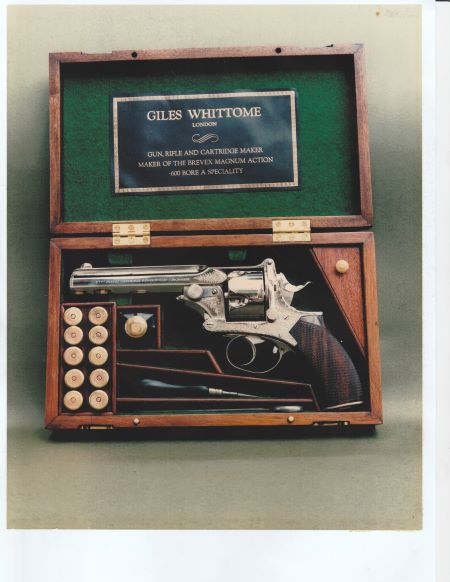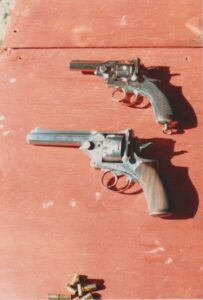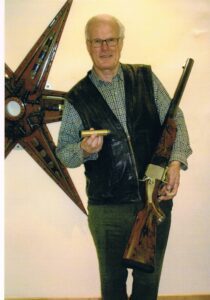By Jim Dickson | Contributing writer
Images courtesy of Giles Whittome
The greatest manstopper revolvers of all time were the .577 revolvers of Victorian England.
Due to the enormous size of their cartridge they were made with 5 shot cylinders which still dwarfed other revolvers then and now. They are called .577 caliber guns because they chambered cartridges made from cut down .577-.450 cases. These are tapered cases so the actual diameter of the bullet and bore is .614-inch and the bullet weight is a whopping 450 grains.
One dram of # 6 black powder completely fills the case behind the bullet and produces 725 fps velocity at the muzzle. Penetration with a hard cast bullet is extreme to say the least. Part of this is because the resistance of a hydraulic medium goes up on the square of the velocity of the projectile impacting it. This is why lower velocity slugs can sometimes out penetrate higher velocity slugs.
The best way to compute the effect of a slug on game is Taylor’s knockout values formula which is bullet weight x velocity x caliber divided by 7,000. The knockout value of the .577-caliber revolver cartridge is a staggering 28.6. To put that into perspective a military .45 ACP has a knockout value of 12.6 and the .318 Westley Richards rifle cartridge firing a 250-grain bullet at 2,400 fps has 27.25 Knockout value.
For those unfamiliar with it the .318 Westley Richards was one of the most popular medium game rounds in the glory days of African hunting holding its popularity even after the .375 H&H magnum came on the scene. Like the .375 H&H it also killed a lot of elephants yet it has less knockout values than the .577 revolver cartridge. For anyone wanting the ultimate handgun hunting or bear shooting revolver this is definitely it.
The .577 revolver saw a lot of use as a manstopper as the British Empire was fighting all sorts of fanatical enemies in those days. Some of these, such as the Sudanese Mahdists and Chinese Boxers, were small-framed men and a bullet could whip through without expending all of its energy. It was important that they be stopped instantly before they had a chance to get close with their swords. A .614 diameter bullet made a big enough hole to accomplish that.
These behemoth big bores were rare even in their day for they were quite a handful and the British are a nation of shotgunners not pistol shooters. There were few men willing to take up the biggest big bore revolver of all time. This resulted in less than a 100 of all makes being produced. Marketing their guns to foreigners was not one of the strong points of the British gun trade of the Victorian era. Had the .577 revolvers been sold in America as bear stoppers they would probably still be in production today.
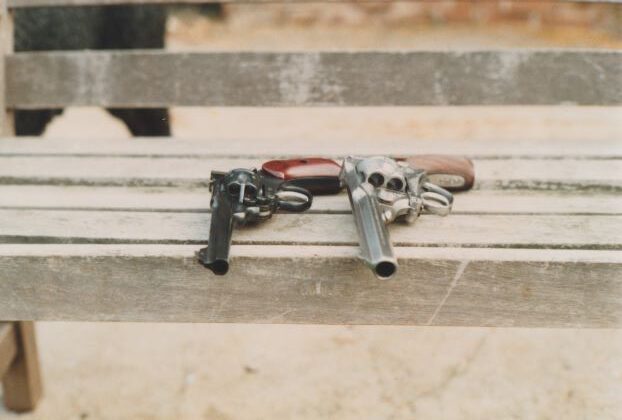
The earliest .577 revolvers were built by Tranter who had to deal with the coiled brass cases used in the first .577-.450 rifles as his parent case. These weak cases could bulge quickly if even a small section was left unsupported so the earliest .577 revolvers were made with a removable back plate to keep things as tight as possible. Unfortunately, this meant that you had to take the cylinder pin out and remove the cylinder and back plate, punch out the empties with a cleaning rod, then reassemble the pieces. As soon as drawn brass .577-.450 cases were adopted this method fell by the wayside to everyone’s relief.
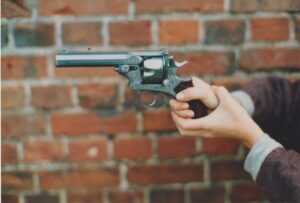
Most of the .577 revolvers were built on the Bland-Pryse top break action in which you squeeze the two levers hinged on the side of the rear of the frame which withdraws the two pins holding the action shut.
In recent years British Best Quality gun maker Giles Whittome found an unfinished .577 revolver on the Bland-Pryse action and I do mean unfinished. Even the barrel had not been rifled.
Giles proceeded to finish the manufacture of this piece to the highest Best Quality standards making it the finest quality .577 revolver ever made. The gun was engraved by Marcus Hunt, son of Ken Hunt, who was for decades accepted as England’s premier engraver. After engraving, it was nickel plated. It was then given a proper case as shown in the photo. It shot good too.
When Giles took Ross Seyfried out to shoot it , Ross fired a cylinder full offhand at between 40 and 50 yards with all the shots going inside a hand span.
Shooting this beast shows why it never caught on more with British officers. It has so much recoil that the muzzle flips all the way straight up with every shot.
These .577 revolvers are not only the greatest man stopper revolvers of all time they are also the greatest hunting and bear stopper revolvers of all time. Sadly, the American shooter is effectively denied them by the BATF which, while making allowances for sporting rifles over .50-caliber, makes no such distinctions for revolvers over .50 caliber and classifies them as “Destructive devices” the same as an 8 inch field artillery piece under 26 USC Section 5845(f).

